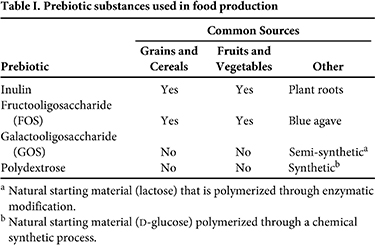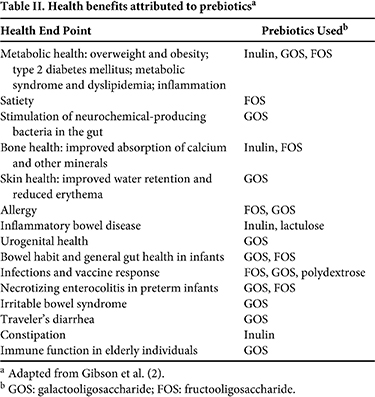|
|
02 Features
Print To PDF
DisplayTitle The Science of Prebiotics
Authors International Scientific Association for Probiotics and Prebiotics1
Affiliations
© 2020 Cereals & Grains Association
Abstract
CFWAbstract Based on the current scientific consensus definition, a prebiotic is “a substrate that is selectively utilized by host microorganisms conferring a health benefit.” For a compound to be considered a prebiotic, it must act as a substrate for health-promoting microorganisms in the digestive tract or elsewhere, and its beneficial physiological effect on the host should be attributable (at least in part) to the utilization of the compound by microbes. This definition allows for a wide range of substances targeting different host niches to be considered prebiotics provided they have appropriate scientific support. Inulin, fructooligosaccharides (FOS), and galactooligosaccharides (GOS) are commonly used to improve flavor and texture, to modify the physicochemical properties of foods, and as low-calorie sweeteners. The use of these ingredients to fortify the dietary fiber content of food products is a more recent development. The designation of inulin, GOS, and FOS as prebiotics is likely to resonate with health-conscious consumers and drive increased demand for foods containing prebiotics.
Trying to reach content?
View Full Article
if you don't have access, become a member
Page Content Gibson and Roberfroid first put forward the concept of a “prebiotic” in 1995 in their scientific publication “Dietary Modulation of the Human Colonic Microbiota: Introducing the Concept of Prebiotics” (3). In the decades that followed, scientists tended to focus on identifying substances that target bifidobacteria and lactobacilli, groups of bacteria in the gut that are widely considered as health-promoting. Today’s scientific definition of a prebiotic was developed by a panel of experts in microbiology, nutrition, and clinical research that was convened in 2016 by the International Scientific Association for Probiotics and Prebiotics (ISAPP) (2). Based on the current consensus definition, a prebiotic is “a substrate that is selectively utilized by host microorganisms conferring a health benefit.” This concept includes three essential parts: a substance, a physiological effect, and a mechanism.
Prebiotic Criteria
Prebiotics are sometimes equated with dietary fibers, but only a subset of dietary fibers truly qualifies as prebiotics. According to this scientific definition, for something to be considered a prebiotic compound it must be shown to act as a substrate for health-promoting microorganisms in the digestive tract or elsewhere; moreover, its beneficial physiological effect on the host should be attributable (at least in part) to the utilization of the compound by microbes. Under this new definition, the potentially beneficial microbial components of the gut microbiota may include more than just bifidobacteria and lactobacilli. However, a prebiotic substance must affect a limited group of microorganisms in the host, rather than the entire microbial ecosystem, to meet the criterion of being “selectively utilized.”
Prebiotic substances may be present in whole foods or in isolated form (Table I). The most commonly studied prebiotics are fructooligosaccharides (FOS) and galactooligosaccharides (GOS). Although the prebiotic substances with the most well-documented health effects to date are fermentable carbohydrates, the new definition allows for a wide range of substances targeting different host niches to be considered prebiotics provided they have appropriate scientific support. Such support would consist of high-quality, adequately powered, randomized, controlled trials that demonstrate selective utilization of the putative prebiotic and improvement in a clinical outcome in the same study (8).
It should be noted that the carbohydrates listed in Table I all meet the accepted definition of a prebiotic and are used ubiquitously within the food industry in a variety of applications. Other fermentable carbohydrates, such as arabinoxylan, resistant starches, pectins, galactomannans, xylooligosaccharides, and isomaltooligosaccharides, are also used in food manufacturing. These substances have all individually been shown to affect the growth of gut microbes. In addition, wheat bran and whole grain wheat fiber have demonstrated effects on gut microbiota composition in their intact forms within commonly consumed foods (6).
Despite promoting gut microbiota diversity and abundance and a few promising clinical study results, none of these carbohydrates currently meet the definition of a prebiotic. To be accepted as prebiotics, controlled trials in the target host that demonstrate selective utilization by the microbiota and a concomitant health benefit are needed (8).
Research on Prebiotics
 Prebiotic substances have been studied for their health-improving and therapeutic effects (Table II). However, the majority of research into their health effects has focused on isolated substances, with less focus on prebiotics as part of whole-plant foods (6). A large number of dietary carbohydrates are capable of producing significant changes to the intestinal microbiota (7), and human clinical data have shown that health benefits are most often associated with changes to the quantities of bifidobacteria and lactobacilli in the gut. As our understanding of the connection between gut microbiota and physiological systems continues to advance, the important role of other bacterial species in health—and their manipulation by prebiotics—will likely become more evident. Prebiotic substances have been studied for their health-improving and therapeutic effects (Table II). However, the majority of research into their health effects has focused on isolated substances, with less focus on prebiotics as part of whole-plant foods (6). A large number of dietary carbohydrates are capable of producing significant changes to the intestinal microbiota (7), and human clinical data have shown that health benefits are most often associated with changes to the quantities of bifidobacteria and lactobacilli in the gut. As our understanding of the connection between gut microbiota and physiological systems continues to advance, the important role of other bacterial species in health—and their manipulation by prebiotics—will likely become more evident.
Use of Prebiotics in Food Applications
Inulin, FOS, and GOS are used in the food industry to improve the flavor and texture and modify physicochemical properties of foods and as low-calorie sweeteners (9,10). Because these carbohydrates are also relatively inexpensive and easy to incorporate into the food manufacturing process, their use as food ingredients is very common (1). The subsequent use of these ingredients to fortify the dietary fiber content of food products has been a more recent development. The designation of inulin, GOS, and FOS as prebiotics is likely to resonate with health-conscious consumers and drive increased demand for prebiotic-containing foods.
Recommendations
As interest in prebiotics continues to grow and gain acceptance with consumers globally, there will be greater interest in obtaining information on the topic. The Internet is an important source of health information for consumers today. Unfortunately, a number of consumer and professional-facing websites currently contain inaccurate information about prebiotics. Consequently, it is incumbent upon the food industry, scientific community, and medical establishment to agree on and adhere to a clear and accepted definition of a prebiotic to help prevent misleading consumers, ensure accuracy in product labeling, and provide guidance to regulators (4). ISAPP offers information resources, including infographics and videos, that provides science-based information on prebiotics.
Currently, there are no official dietary recommendations for “adequate intake” or “recommended daily allowance” of prebiotics by healthy individuals. Most prebiotics targeting the gut require an oral dose of >3 g/day to confer a health benefit. Typically, around 5 g is the target for FOS and GOS in the daily diet—an amount that includes plant sources of prebiotics.
In the United States, the Institute of Medicine recommendation for daily dietary fiber intake ranges from 19 g/day to 38 g/day, depending on gender and age (5). FOS, GOS, and inulin are all considered by the U.S. Food and Drug Administration to be soluble fibers that contribute to the total recommended dietary intake of fiber.
The International Scientific Association for Probiotics and Prebiotics (ISAPP) is a nonprofit scientific organization dedicated to advancing the science of probiotics and prebiotics. Its activities, which are determined by an all-academic board, are funded by dues paid by companies whose interests and actions are aligned with ISAPP’s scientific mission and support further research. Website: www.ISAPPscience.org
References References
- Berry, D. Probiotics and prebiotics: The future is now. Published online at www.foodbusinessnews.net/articles/4111-probiotics-and-prebiotics-the-future-is-now. FoodBusinessNews.net, 2014.
- Gibson, G. R., Hutkins, R., Sanders, M. E., Prescott, S. L. Reimer, R. A., et al. Expert consensus document: The International Scientific Association for Probiotics and Prebiotics (ISAPP) consensus statement on the definition and scope of prebiotics. Nat. Rev. Gastroenterol. Hepatol. 14:491, 2017.
- Gibson, G. R., and Roberfroid, M. B. Dietary modulation of the human colonic microbiota: Introducing the concept of prebiotics. J. Nutr. 125:1401, 1995.
- Hutkins, R. W., Krumbeck, J. A., Bindels, L. B., Cani, P. D., Fahey, G., Jr., et al. Prebiotics: Why definitions matter. Curr. Opin. Biotechnol. 37:1, 2016.
- Institute of Medicine, Food and Nutrition Board. Dietary Reference Intakes: Energy, Carbohydrates, Fiber, Fat, Fatty Acids, Cholesterol, Protein and Amino Acids. National Academies Press, Washington, DC, 2005.
- Jefferson, A., and Adolphus, K. The effects of intact cereal grain fibers, including wheat bran on the gut microbiota composition of healthy adults: A systematic review. Front. Nutr. 6:33, 2019.
- Krumbeck, J. A., Maldonado-Gomez, M. X., Ramer-Tait, A. E., and Hutkins, R. W. Prebiotics and synbiotics: Dietary strategies for improving gut health. Curr. Opin. Gastroenterol. 32:110, 2016.
- Sanders, M. E., Merentsin, D. J., Reid, G., Gibson, G. R., and Rastall, R. A. Probiotics and prebiotics in intestinal health and disease: From biology to the clinic. Nat. Rev. Gastroenterol. Hepatol. 16:605, 2019.
- Shoaib, M., Shehzad, A., Omar, M., Rakha, A., Raza, H., Sharif, H. R., Shakeel, A., Ansari, A., and Niazi, S. Inulin: Properties, health benefits and food applications. Carbohydr. Polym. 147:444, 2016.
- Torres, D. P. M., Gonçalves, M. P. F., Teixeira, J. A., and Rodrigues, L. R.. Galacto‐oligosaccharides: Production, properties, applications, and significance as prebiotics. Compr. Rev. Food Sci. Food Safety 9:438, 2010.
|
